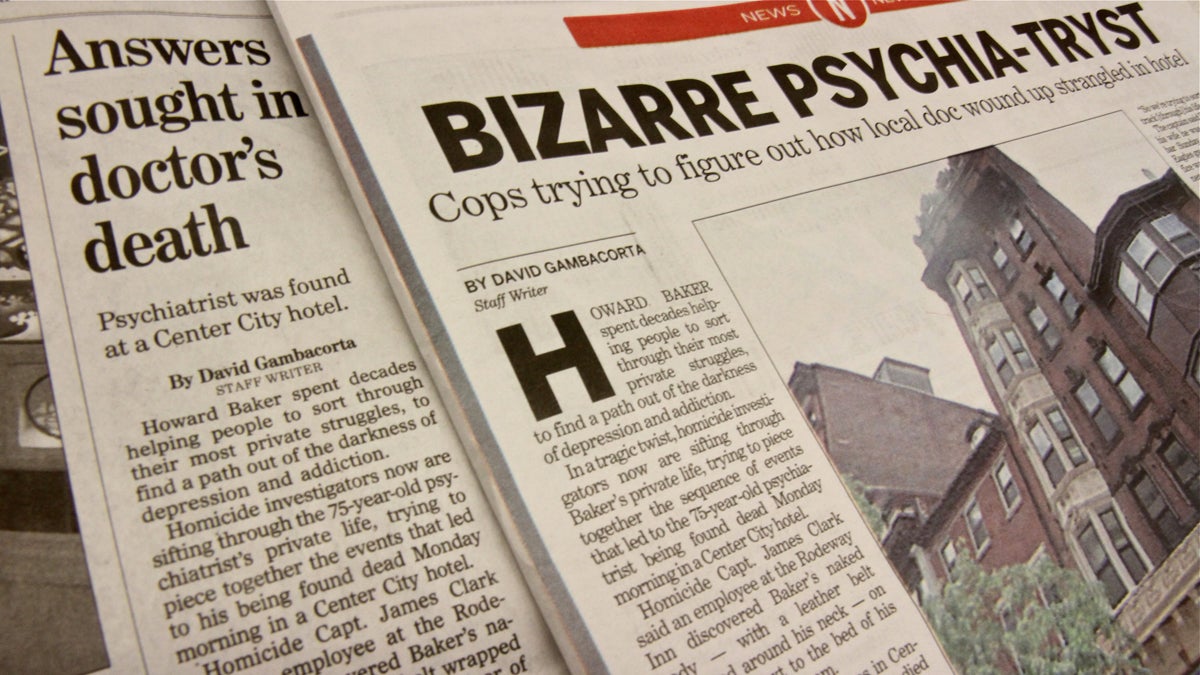Same story, different pitches from Philly papers

The same story ran with wildly different headlines and placement in Wednesday's Inquirer (left) and Daily News. (Emma Lee/WHYY)
What happens when a sassy tabloid like the Philadelphia Daily News and a respectable broadsheet like the Philadelphia Inquirer combine newsrooms?
You get identical stories in both papers with very different headlines.
Check out Wednesday’s coverage.
On the inside of the Inquirer’s local news section, a one-column story appears under the headline, “Answers sought in doctor’s death.” It’s about a psychiatrist found dead in a hotel room, naked with a belt around his neck. The story notes there were no signs of struggle and no injuries to the body, and that police weren’t calling it a homicide.
The Daily News played the story on the front page with the headline, “DOOM SERVICE.” Above the story on page three, the headline was “BIZARRE PSYCHIA-TRYST,” with the subhead, “Cops trying to figure out how local doc wound up strangled in hotel.”
The story in both papers is nearly identical, written by Daily News reporter David Gambacorta.
Other examples, all from Wednesday’s coverage:
Inquirer headline: “Justice Eakin Suspended over Emails.” Daily News headline: “Taxpayers: You’ll pay justice to sit off the bench.”
Inquirer headline: “Report: L&I mishandled inspections.” Daily News headline: “Audit demolishes L&I wrecking practices.”
Inquirer headline: “Budget deal for Christmas possible.” Daily News headline: “Do you believe this shift?”
In all cases, the headlines were above largely identical stories, written by the same reporter.
Why is this happening?
The papers and the website Philly.com are owned by wealthy philanthropist H.F. “Gerry” Lenfest. Faced with declining revenues, the company announced this fall it would combine the newsrooms and lay off dozens of employees.
But both papers continue to publish. Even if they share a lot of copy, they have different personalities and largely different readerships.
I called both papers and the company spokeswoman, and got a call back from Daily News editor Michael Days. (Disclosure: He’s my old boss. I wrote for the paper for just short of 20 years.)
“The Daily News is a street-sale paper,” Days said. “We know from research over the years that we have only a few seconds to grab the reader’s attention, so he or she decides to buy the paper.”
Thus, Days said, the dead naked psychiatrist was a natural to lead the paper.
“We wanted to be respectful – my goodness, a man was killed in a hotel room in Center City,” he said, “but it needed to have a little pop to it.”
This is, of course, hardly news for tabloids.
But in the new media world in Philadelphia, the tabloid and the broadsheet are sharing staffs and planning coverage together so they don’t overlap.
They’ll try to maintain their distinct identities through some unique and original reporting, as well as separate columnists, editorial pages, and of course those headlines.
WHYY is your source for fact-based, in-depth journalism and information. As a nonprofit organization, we rely on financial support from readers like you. Please give today.


